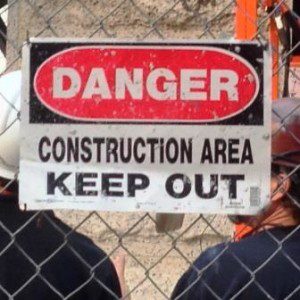
Open and obvious dangers present themselves every day. Cliffs or holes beside a road or walkway. Construction debris. The shallow end of a swimming pool, where reasonable people would never dive head-first.
But in an injury claim where an insurer says the danger was open and obvious, does that end the case?
Consider a carpenter assigned to a job in a massive construction project. The site is cluttered with pieces of pipe, electrical conduit and sections of large lumber. Looking for markings indicating the wall was part of his job, he peered behind a stack of sheetrock.
But, when he attempted to look behind the stacked sheetrock, it pulled away from the wall, collapsing on him, pinning him to the floor. Catastrophic permanent injuries included a disabled right knee.
Court Rulings on Open and Obvious Theory
The carpenter’s injury claim was dismissed. The court concluded that the stacked sheetrock posed an open and obvious danger. The lower court held neither the general contractor nor subcontractor had any duty to warn of the danger presented by stacks of sheetrock.
On appeal, the court held so far so good. But, the dismissal was reversed, the court saying there can in fact be a duty to remedy such open and obvious danger where the hazard is permitted to remain. In other words, the owner or person in control of property is not relieved from remedying an open and obvious danger when it can and should anticipate that the dangerous condition will cause physical harm, despite the open and obvious nature of the condition.
The fact that a condition is open and obvious, and should have been avoided by the injured person cuts both ways. Those in control of the property should also have noticed the open and obvious condition and taken steps to reduce the likelihood of injury. In the above case it didn’t help that a supervisor had observed hazardous debris several times, violating OSHA and the general contractor’s own safety program.
Open and Obvious Law Applied
The court in Docos v. Moriarty & Associates, decided in 2011 by the Massachusetts Court of Appeals made no new or outlandish law. The ruling cites the time honored Restatement of Torts in holding that the open and obvious defense wasn’t proper on the facts of this case.
The same concept has been applied in cases involving a trampoline next to the deep end of a swimming pool, dangerously slippery ice near the entrance to a big box store and injuries caused by defective products.
The ‘open and obvious’ defense can be fatal to a case. For example in a claim by a person walking in a campground, tripping over one of the many exposed tree roots in the area, dismissal of the case was upheld. So, overcoming this defense requires in depth analysis of any given case and well-honed argument targeted at the unique facts of the case.
Views: 1




